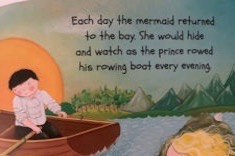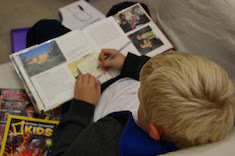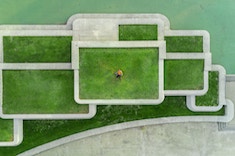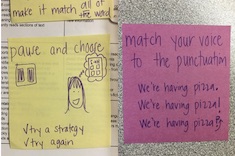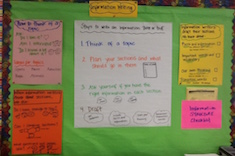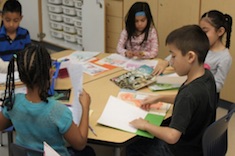Assessment Tools
Making sense of the enormous amount of student data in any classroom or school is probably the biggest challenge we face individually and in our school communities. Here you'll find everything from one-page templates created by teachers for use in their classrooms to videos of staff teams poring over large data sets. We don't have all the answers, but we do provide tools to help you ask better questions as you evaluate students and talk about assessments with your colleagues.
Latest Content
The Power of Teaching Journals
Bitsy Parks finds inspiration for her teaching journal in the work of Debbie Miller. She explains how she uses her journal daily, and how it has evolved over time.
Remembering the Big Picture in Reading Assessments
Kate Mills notes her own miscues in reading a bedtime story to her young children, and thinks about what that means for analyzing the running records of readers in primary classrooms.
Making Learning Stick: Learning Progressions and Student-Created Exemplars
Tammy Mulligan explains the process of having students analyze and create models of good writing and analysis for assessing themselves and peers.
Can a High-Stakes Assessment Create Readers?
Stephanie Affinito encounters an unexpected by-product of testing for her son—the uninterrupted reading time waiting for others to finish builds a good habit. She shares how teachers might reclaim 10 minutes a day for independent reading.
Teaching Constructed Response Before Exams
Teaching the genre of tests can seem far removed from writing workshop. Matt Renwick explores how to teach constructed response in a way that is integrated with the tenets of good workshop instruction.
Status of the Class: Reflecting on Reading Communities
Franki Sibberson uses status of the class each day as a window into her fledgling reading community.
A Better Status of the Class
Dana Murphy finds that adding numbers of pages to her status-of-the-class list for reading makes all the difference in assessing students’ growth and needs as readers.
Releasing the Teaching to Students
Mark Levine releases responsibility for teaching and assessment to students late in the school year, and hears echoes of learning from previous units.
Forming Groups Using a Planner
Dana Murphy explains how her small-group planner is an essential tool for organizing groups in her fourth-grade classroom.
Don’t Forget to Marvel
Ruth Ayres is interrupted during a busy day by a first-grade teacher who enthuses over the details in a student draft. This leads to some reflection on the importance of taking time to marvel.
Think Small
Christy Rush-Levine realized she had to help her students find a different “why” for their time in her classroom and school beyond test scores and standards dictates.
Secret Reader
Suzy Kaback marvels at a very young learner who is a “secret reader,” and this leads her to reassess the value of constantly celebrating new skills in school communities.
Google It!
Ruth Ayres encourages her son to use the web for assistance when doing homework, and then has to ponder whether what she is advocating qualifies as cheating.
Mindful Test-Taking
High-stakes tests weigh on teachers and students through the winter and spring. Mark Levine shares mindfulness strategies for test-taking, explaining how to help students recommit and refocus in the midst of an exam.
Building Habits with Short-Term Goals
Tara Barnett and Kate Mills explain why short-term writing goals can help students reset expectations for their writing on a daily basis, and how they make these goals an integral part of their writing workshops.
Reset
Christy Rush-Levine finds her students sometimes need to stop and be challenged to think in more positive ways about their reading abilities. She describes how she designs minilessons for impromptu resets in her middle school classroom.
When Students Set Intentions
When students set intentions, reflection and celebration go hand in hand. Melanie Meehan explains how teachers can help students become more explicit about intentions with practical cues from bulletin boards and index cards.
Avoiding Flat Tires
Jen Schwanke gets berated by a tire shop repair guy for ignoring routine maintenance needs on her bike. That gets her thinking about what needs routine maintenance in elementary classrooms.
Rethinking Spring Assessments
It's May, and teachers everywhere are preparing for final assessments of students. Jennifer Schwanke explains why it might be time to rethink or even ditch some of those plans.
Looking Forward with Students
Melanie Meehan uses reflective questions and video to build a library of materials at the end of the year to use with next year's class.
Puppy Chow
How do you know an assignment is authentic and worthy of your students' time? Suzy Kaback explains why you need to try it out yourself first.
Reimagining Reading Logs
Reading logs have fallen out of favor in many classrooms because they often become a rote activity for recording pages read. Tara Barnett and Kate Mills find authenticity with the logs comes when they move from emphasizing recording to goals and reflection.
Meaningful Data
Ruth Ayres explains how data can make students and teachers feel empowered or deflated—so much depends on what you are looking for and how you present it.
Asking Students to Grade Themselves
Asking students to assess and grade their own work cements learning and deepens understanding for many students, but only if it is done in a thoughtful, collaborative way. Melanie Meehan takes you step-by-step through the process in a fifth-grade classroom.
Leveraging Reading Assessment Benchmarks
Benchmark assessments can be incredibly time-consuming for teachers to complete. Tara Barnett and Kate Mills describe how they leverage the time spent by using the assessments in strategy conferences with students.
Bulletin Board of Independence
Melanie Meehan uses independence bulletin boards to provide students with options when working on their own during units of study.
Students Watching Teachers
Students are always watching us, whether we realize it or not. Jennifer Schwanke explains how we can capitalize on that interest to build independent reading and writing habits.
Self-Assessment and Goal Setting
Gigi McAllister is disappointed by the shallow and unexpected responses by her fourth graders to literacy rubrics at the end of the year. The experience sends her on a quest to do a better job of helping her students learn to set goals and understand what measurable progress looks like over time.
Goals to Habits in First Grade
Bitsy Parks finds goals aren’t enough for her first-grade students—real growth requires that the goals eventually become habits. She develops a process mid-year to help children refine their goals step-by-step.
Goals in Small Groups for English Language Learners
Setting small-group goals can be tricky, and the complexity is compounded when you are working with English language learners. Kate Mills explains her goal-setting process with K-3 ELLs, and gives examples of how it works.
Browse Content By
Type
Category
- Assessment Tools
- Big Fresh Archives
- Booklists
- Choice Numeracy
- Classroom Design
- Common Core
- Community Building
- Conferring
- Content Literacy
- Digital Literacy
- English Language Learners
- Equity
- Family Relations
- Free Samples
- Guiding Groups
- Leadership
- Literacy Coaches
- Mentor Texts
- Minilessons
- New Teacher Mentors
- Podcasts
- Poetry
- Quote Collections
- Reading Strategies
- Self Care
- Struggling and Striving Learners
- Talking and Listening
- Teacher Study Groups
- Teaching Reading
- Teaching Writing
- Word Study and Vocabulary
Author
- Melissa Quimby
- Nawal Qarooni
- Gwen Blumberg
- Julie Cox
- The Lead Learners
- Hannah Tills
- Josie Stewart
- Ruth Metcalfe
- Mallory Messenger
- Becca Burk
- Jodie Bailey
- Vivian Chen
- Mary Brower
- Tiffany Abbott Fuller
- Stephanie Affinito
- Ruth Ayres
- Leigh Anne Eck
- Heather Fisher
- Shari Frost
- Julie Johnson
- Suzy Kaback
- Gigi McAllister
- Shirl McPhillips
- Melanie Meehan
- Cathy Mere
- Debbie Miller
- Tara Barnett and Kate Mills
- Tammy Mulligan
- Dana Murphy
- Bitsy Parks
- David Pittman
- Brenda Power
- Heather Rader
- Matt Renwick
- Mandy Robek
- Christy Rush-Levine
- Gretchen Schroeder
- Jen Schwanke
- Brian Sepe
- Katherine Sokolowski
- Stella Villalba
- Jennifer Vincent
Grade Level
Choice Literacy Membership
Articles
Get full access to all Choice Literacy article content
Videos
Get full access to all Choice Literacy video content
Courses
Access Choice Literacy course curriculum and training


